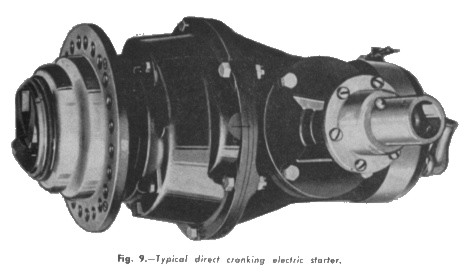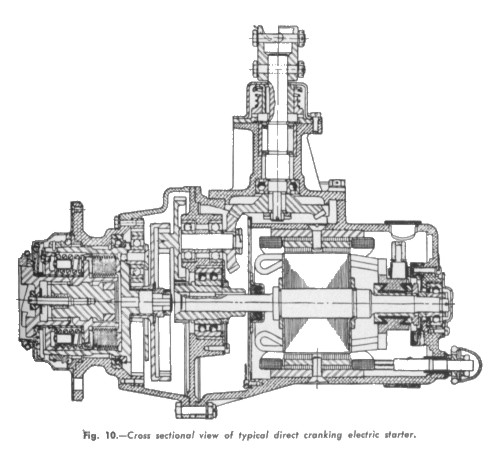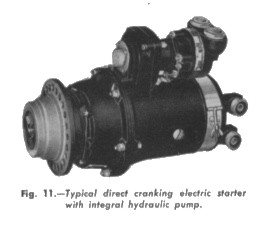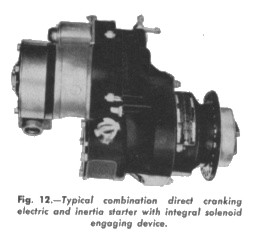|

electrical
starters
The increased use in aircraft of batteries and generators for
battery charging has made available current sources of
sufficient capacity to provide adequately for the electrical
requirements of the direct cranking electric type of aircraft
engine starters. The Direct Cranking Electric Starter presents
many advantages which recommend its use in installations,
where convenient engine starting is desired. The starter,
controlled from the cockpit, provides instantaneous and
continuous 'cranking. This feature is desirable in private and
commercial air transport installations, where sufficient
battery capacity is available, as it permits prompt starting
without external assistance. Direct cranking electric starters
are available in capacities for engines rated from 50 to 1500
horsepower.
This type of starter consists basically of
an electric motor, a gear reduction and an automatic engaging
and disengaging mechanism, which operates through an
adjustable torque overload release. The engine is cranked
directly by the starter and there is no preliminary storage of
energy as with the inertia type of starter. Therefore, it can
be assumed that for a specific engine under extreme low
temperature conditions, with resultant high cranking torque,
the current consumption will be somewhat higher than would be
the case with an electric inertia starter on the same engine
under similar conditions, because of the direct connection
between the starter motor and the engine during the cranking
period. The direct cranking electric starter is intended for
use on large commercial transports and privately owned
airplanes, which are normally stored in hangars and are not
subject to cold weather starting. The use of external
batteries in the form of a dolly are recommended for cranking
engines of large aircraft transports equipped with direct
cranking electric starters in order to save the airplane
batteries.

Direct Cranking Starters
The direct cranking electric starters are
normally furnished less hand crank mechanism with the
exception of large capacity units which are supplied with a
hand crank mechanism if required. The starters are designed
for operation from a 12 or 24 volt battery source. Upon the
application of current to the motor terminals, the torque of
the motor is transmitted through a gear reduction unit to the
adjustable torque overload release, which in turn actuates a
splined screw shaft which moves the starter jaw axially
outward into engagement with the engine cranking member before
the starter jaw begins to rotate. Thus, complete engagement is
effected before cranking commences. The torque overload
release in the form of a multiple disc clutch is adjusted to a
predetermined value so as to deliver sufficient, yet not
excessive cranking torque to the engine. In case of engine
back-fire, the clutch slips, preventing damage to the engine
and starter. With this type of starter, engine cranking is
continuous but at a lower speed than that obtained with the
inertia type of starter. The current draw of the direct
cranking electric starter varies directly with engine size and
torque characteristics. It will therefore be considerably
higher than that required for the operation of the inertia
type starters.

The Combination Direct Cranking Electric
Starter With Integral Hydraulic Feathering Pump
The direct cranking electric starter with
integrally mounted hydraulic feathering pump has been
developed to replace the standard type of direct cranking
electric starter and separately mounted electric motor driven
hydraulic feathering pump for installations utilizing the
Hamilton Standard Hydromatic Propeller. Primarily designed and
developed for use in conjunction with Hamilton Standard
Hydromatic Propellers, the starter pump unit incorporates all
of the features of the conventional direct cranking electric
starter, with the exception that the hand crank mechanism
fitted to starters of this type has been removed and a
hydraulic pump mounted in its place. With this type of
starter, a reversible motor is utilized in order to permit
driving of the hydraulic feathering pump when the starter is
not in operation. The starter pump unit, in addition to
providing a saving in weight due to the elimination of an
additional electric motor and excess line tubing, provides a
compact and light weight installation integral with the power
plant and available for operation as required. The design of
the starter pump unit is such that when used in conjunction
with two solenoid starting relays, battery booster coil and a
suitable control switch, remote control of both starter and
feathering pump is provided. As with the conventional type of
direct cranking electric starter, jaw engagement is automatic
upon closing of the motor circuit. An overrunning clutch,
interposed between the starter and pump provides starter
operation without rotation of the hydraulic pump. The
hydraulic pump, which may be of either the internal or
external gear type, provides a dependable and efficient source
of hydraulic pressure for the feathering and unfeathering of
Hamilton Standard Hydromatic Propellers.

Combination Direct Cranking Electric And
Inertia Starter Wit11 Integral Solenoid Engaging Device
Among the most outstanding recent
developments in aircraft engine starting equipment has been
the combination direct cranking electric and inertia starter,
which incorporates all the features of the hand or combination
hand and electric inertia starters and in addition, provides,
by means of a heavy duty integral accelerating motor,
continuous cranking of the aircraft engine after dissipation
of the flywheel kinetic energy. Thus the energy stored in the
starter flywheel at the initial engagement of the starter and
engine jaws is used to overcome the heavier breakaway torque
after which the lighter load of continuous cranking is assumed
by the electrical system. The result is notably less drain on
the source of electrical energy with greater convenience and
starting ease. Although only available at the present time for
use in conjunction with engines, rated at approximately from
1500 to 1800 horsepower, this starter can be readily modified.
The design of the starter is such, that
when used in conjunction with a separately mounted solenoid
starting relay, battery booster coil and three position
starter control switch, remote control of motor acceleration
and starter jaw engagement is provided. The starter may be
operated as a direct cranking electric starter or as a
combination, direct cranking electric and inertia starter, by
means of the control switch, as required. For cold weather
starting, operation of the unit as a combination direct
cranking electric and inertia starter is recommended, whereas
for warm weather starting or where immediate continuous
cranking is desired, the unit may be operated as a direct
cranking electric starter. For emergency operation when the
source of electrical energy is not sufficient to permit proper
electrical operation as a combination direct cranking electric
and inertia starter, the unit may be operated as an electric
inertia starter, in which case manual engagement of starter
and engine jaws is required. In addition, the unit may be
operated as a hand inertia starter for emergency operation, in
which case it is also necessary to manually engage the starter
and engine jaws. A universal hand crank mechanism is provided
on these starters with provisions for either clock or counter
clock rotation hand cranking. With this type of hand crank
mechanism the position for hand crank take off may be readily
adjusted to facilitate starter installation, available for 12
or 24 volt operation.

|
